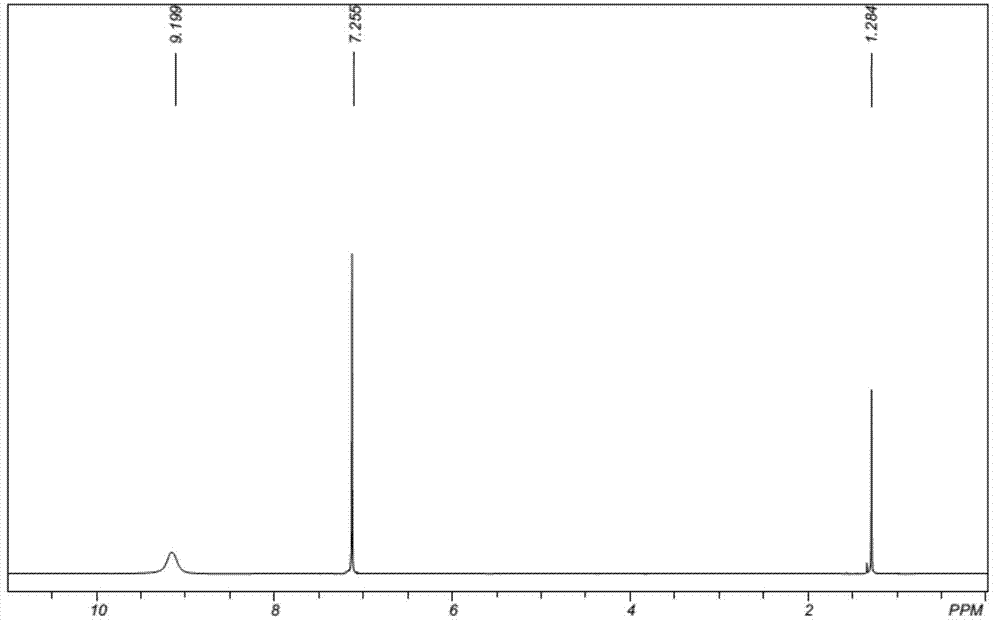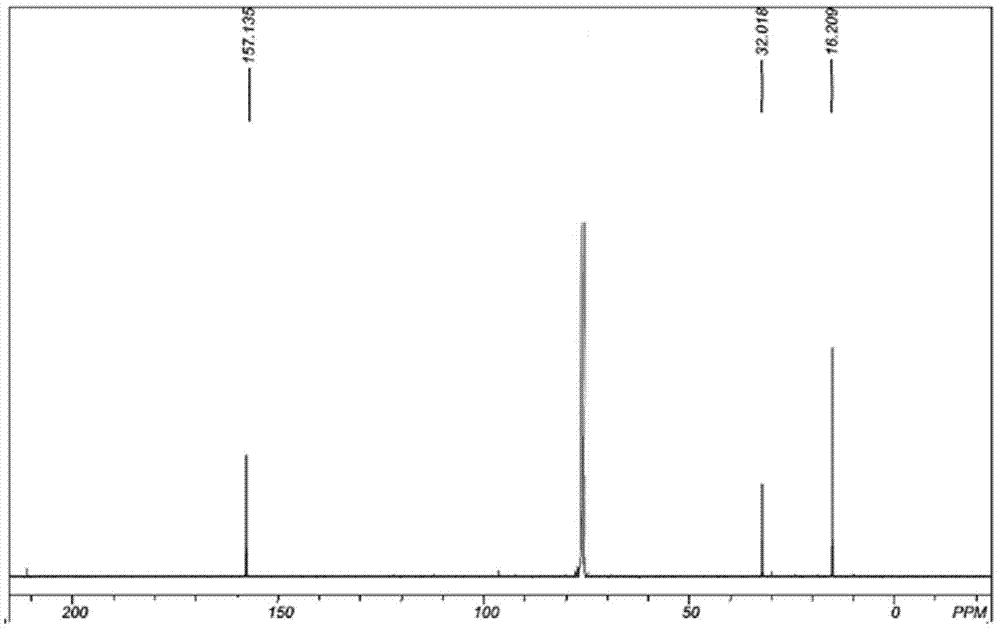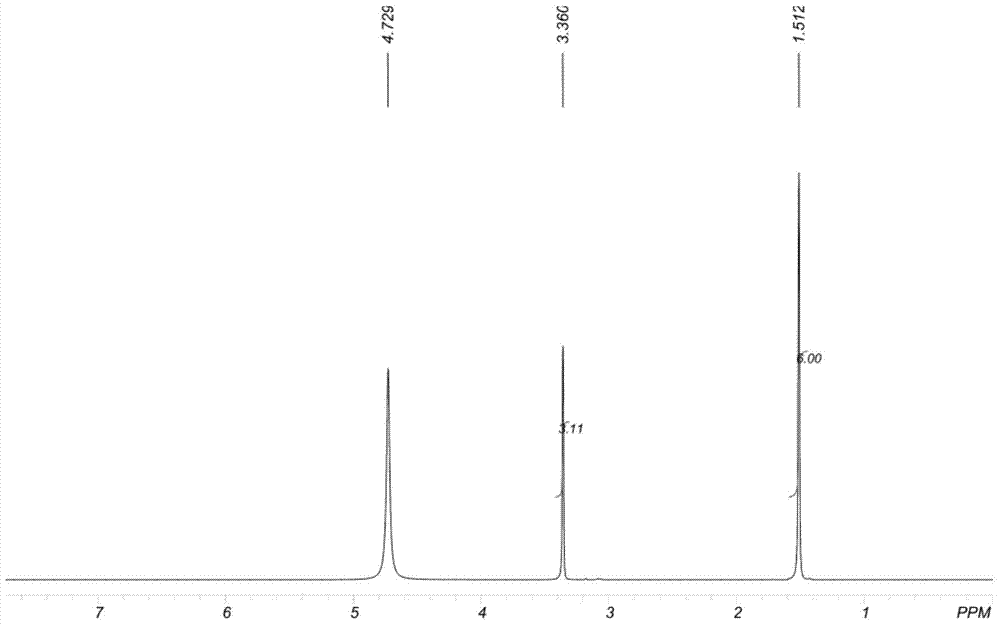Method for preparing 2-amino-2-methyl-1-propionic ester
A technology of propionate and methyl, which is applied in the field of preparation of 2-amino-2-methyl-1-propionate, can solve problems such as low conversion rate, recrystallization, and long reaction holding time, and achieve route cost The effect of low cost, wide range of sources, and simple operation of the reaction steps
- Summary
- Abstract
- Description
- Claims
- Application Information
AI Technical Summary
Problems solved by technology
Method used
Image
Examples
Embodiment 1
[0049] (1). Dimerization of dimethyl ketene: Weigh 70.04g (1.00mol) dimethyl ketene and dissolve it in 200g ethyl acetate, put the ethyl acetate solution dissolved in dimethyl ketene in 500ml In a three-necked flask, raise the temperature to 70° C., and keep it warm for 2 hours to obtain a dimerization reaction solution. Ethyl acetate was distilled off from the reaction solution at 0.02 MPa and 50° C. to obtain 69.88 g of solid.
[0050] (2). Preparation of 2,2,4,4-tetramethyl-1,3-cyclobutanedione oxime: 69.88g of the solid obtained in step (1) (based on the complete reaction of dimethyl ketene, 0.50mol ) and 70.19g (1.01mol) of hydroxylamine hydrochloride were placed in a 500ml three-necked flask containing 160g (5.00mol) of methanol, after the temperature was raised to 20°C, ammonia was slowly introduced into the reaction system under stirring, and the reaction temperature was maintained at 20°C. The pH of the system was 8-12. After continuing to pass through for 4 hours, s...
Embodiment 2
[0061] (1).Dimerization of dimethylketene: Weigh 210.12g (1.50mol) dimerization product 2,2,4,4-tetramethyl-1,3-cyclobutanedione of dimethylketene Add it into a 500ml three-necked flask, raise the temperature to 120°C, add 70.04g (1.00mol) of dimethyl ketene dropwise under normal pressure, after the addition is complete, continue to raise the temperature to 140°C, and keep it warm for 1.5h to obtain dimethicone Polymerization solution. After cooling to room temperature, 277.32 g of solid were obtained.
[0062] (2). Preparation of 2,2,4,4-tetramethyl-1,3-cyclobutanedione oxime: 69.33 g of the solid obtained in step (1) (based on the complete reaction of dimethyl ketene, 0.50 mol ) and 82.89g (1.01mol) of hydroxylamine sulfate were placed in a 1000ml three-necked flask containing 480g (15.00mol) of methanol, after the temperature was raised to 40°C, solid sodium carbonate was slowly added to the reaction system under stirring, and the reaction temperature was kept at 40°C. Th...
Embodiment 3
[0066] (1). Dimerization of dimethyl ketene: Weigh 70.04g (1.00mol) dimethyl ketene and dissolve it in 140g ethyl acetate, and place the ethyl acetate solution dissolved in dimethyl ketene in 500ml In a three-necked flask, raise the temperature to 110° C., and keep it warm for 3 hours to obtain a dimerization reaction solution. The reaction solution was evaporated to dry ethyl acetate at 0.02 MPa and 50° C. to obtain 69.45 g of solid.
[0067] (2). Preparation of 2,2,4,4-tetramethyl-1,3-cyclobutanedione oxime: 69.45 g of the solid obtained in step (1) (based on the complete reaction of dimethyl ketene, 0.50 mol ) and 68.98g (1.05mol) of hydroxylamine phosphate were placed in a 500ml three-neck flask containing 160g (5.00mol) of methanol, and after the temperature was raised to 40°C, ammonia gas was slowly introduced into the reaction system under stirring, and the reaction temperature was kept at 40°C. The pH of the system is 8-12. After continuous feeding for 2 hours, the fe...
PUM
 Login to View More
Login to View More Abstract
Description
Claims
Application Information
 Login to View More
Login to View More - R&D
- Intellectual Property
- Life Sciences
- Materials
- Tech Scout
- Unparalleled Data Quality
- Higher Quality Content
- 60% Fewer Hallucinations
Browse by: Latest US Patents, China's latest patents, Technical Efficacy Thesaurus, Application Domain, Technology Topic, Popular Technical Reports.
© 2025 PatSnap. All rights reserved.Legal|Privacy policy|Modern Slavery Act Transparency Statement|Sitemap|About US| Contact US: help@patsnap.com



